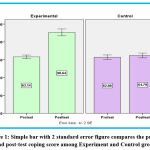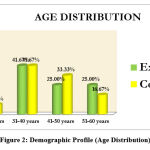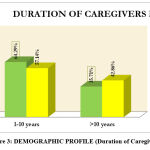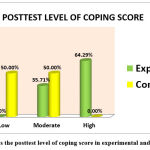Manuscript accepted on :22-06-2022
Published online on: 01-07-2022
Plagiarism Check: Yes
Reviewed by: Dr. Adamu Birhanu
Second Review by: Dr. Umargani Jamal mohamed
Final Approval by: Dr. Ian James Martin
Ajithakumari1* . G and V. Hemavathy
. G and V. Hemavathy
1Department of psychiatric Nursing, Sree Balaji College of Nursing, Bharath Institute of Higher Education and Research, Chennai, Tamilnadu, India
2Sree Balaji College of Nursing, Bharath Institute of Higher Education and Research Chennai, Tamilnadu, India
Corresponding Author E-mail: ajitharaghu01@gmail.com
DOI : https://dx.doi.org/10.13005/bpj/2444
Abstract
Caregivers of patients with schizophrenia face stress and emotional hardship and are frequently forced to assume lifelong caregivers role. For many families having a relative with mental illness can be a stressor. (2) To test the feasibility and practicability of the study, a pilot study was conducted among 28 caregivers of schizophrenia. True Experimental Research design was adopted in this study. Conclusion: This pilot study concludes by proving the effectiveness of psychosocial interventions on coping strategies among caregivers of schizophrenia.
Keywords
Coping Strategies; Caregivers; Psychosocial Intervention; Schizophrenia
Download this article as:| Copy the following to cite this article: Ajithakumari G, Hemavathy V. Coping Strategies among Caregivers of Schizophrenia--A Pilot Analysis. Biomed Pharmacol J 2022;15(2). |
| Copy the following to cite this URL: Ajithakumari G, Hemavathy V. Coping Strategies among Caregivers of Schizophrenia--A Pilot Analysis. Biomed Pharmacol J 2022;15(2). Available from: https://bit.ly/3bAfklj |
Introduction
Schizophrenia is a severe mental disorder affecting about 1% of the human population with relatively uniform distribution throughout the world. Being chronic and often incapacitating, it extracts tremendous costs from patients, families and society. Caregivers of patients with schizophrenia face stress and emotional hardship and are frequently forced to assume lifelong caregivers role. For many families having a relative with mental illness can be a stressor. Ignorance and misconceptions among the caregivers of patients, deinstitutionalization policy and lack of resources cause serious burden of disease among caregivers. Many families believe that they do not have the necessary coping strategies to help with managing the mental illness of their relatives. Severe mental illness like schizophrenia have a devastating impact on the patients as well as their family members. 2
Materials and Method
To test the feasibility and practicability of the study (1), a pilot study was conducted among 28 caregivers of schizophrenia in the same procedure as that of the original study in Sree Balaji Medical College and Hospital, Chennai. Data was analyzed to find out the suitability of the statistics.
Aim of this Study
The aim of the study was to assess the effectiveness of psychosocial interventions on coping strategies among the caregivers of schizophrenia in Sree Balaji Medical College and Hospital, Chennai
Objectives of the Study
To determine pretest level of coping strategies among caregivers of schizophrenia in experimental and control group.
To assess and compare posttest level of coping strategies among caregivers of schizophrenia in experimental and control group.
To evaluate the effectiveness of psychosocial interventions between experimental and control group
To associate the demographic variables with posttest level of coping score in experimental group
Research Methodology
Research Approach
A research approach is the umbrella that covers the basic procedure for conducting research. (Treece&Treece, 1986). Selection of the research approach is a basic procedure to conduct a research .In view of the problem selected for the study and objective to be accomplished, the investigator evaluates the effectiveness of psychosocial interventions among the caregivers of schizophrenic patients hence Quantitative evaluative research approach was considered as an appropriate research approach for this study
Research Design
True Experimental Research design was adopted in this study.
Variables
Demographic variables of this study include age, religion, gender, level of education, relationship, Perceived income adequacy, employment Status, Duration of caregivers role, Losing Job because Of Care Giving Responsibility, Marital Status, place of Residence and type of family
Sample
Caregivers of schizophrenia who fulfilled the inclusion criteria were selected as samples
Criteria for Sample Selection
The samples for the study were selected based on the following criteria
Inclusion Criteria
The caregivers of clients diagnosed with schizophrenia caring for 6 months or more.
The caregivers who were willing to participate in this study.
The caregivers who speak and understand Tamil or English.
The caregivers who belong to the age group of 18 -60 years will be included.
The caregivers who were willing to come for follow up.
Exclusion Criteria
Caregivers of other psychiatric conditions will be excluded from the study.
The caregivers who are having any hearing difficulty were excluded from the study.
Research Tool and Technique
Part I
It consisted of a structured interview guide with questions related to the demographic data of the caregivers’ of schizophrenic patient
Part II
The Family Crisis Oriented Personal Evaluation Scales (F-COPES), developed by Hamilton McCubbin, David Olson, and Andrea Larsen (1981), was created to identify problem solving and behavioral strategies utilized by caregivers in difficult or problematic situations.(3)
Ethical Considerations
The proposed study was conducted after the approval of ethical committee of Sree Balaji Medical College and Hospital, Chennai. Permission was obtained from the Head of the Institution. Due consent was obtained from the Dean of Sree Balaji Medical College and Hospital and the head of the Psychiatric department for the pilot study. Informed consent of each subject was obtained before starting the data collection and assurance was given to them that the anonymity of each individual would be maintained.
Table 1: Demographic Profile
|
Demographic variables |
Group | ||||
| Experimental (n=14) | Control(n=14) | ||||
| n | % | n |
% |
||
| Age | 18-30 years | 6 | 42.86% | 5 | 35.71% |
| 31-40 years | 3 | 21.43% | 5 | 35.71% | |
| 41-50 years | 3 | 21.43% | 2 | 14.29% | |
| 51-60 years | 2 | 14.29% | 2 |
14.29% |
|
| Religion | Hindu | 10 | 71.43% | 9 | 64.29% |
| Muslim | 2 | 14.29% | 2 | 14.29% | |
| Christian | 2 | 14.29% | 3 | 21.43% | |
| Gender | Male | 5 | 35.71% | 6 | 42.86% |
| Female | 9 | 64.29% | 8 | 57.14% | |
| Level Of Education | Illiterate | 4 | 28.57% | 4 | 28.57% |
| Elementary | 3 | 21.43% | 5 | 35.71% | |
| Secondary | 7 | 50.00% | 5 | 35.71% | |
| High school | 0 | 0.00% | 0 | 0.00% | |
| College | 0 | 0.00% | 0 | 0.00% | |
| Relationship With The Patient | Spouse | 7 | 50.00% | 6 | 42.86% |
| Parents | 4 | 28.57% | 4 | 28.57% | |
| Sibling | 2 | 14.29% | 2 | 14.29% | |
| Children | 1 | 7.14% | 2 | 14.29% | |
| Perceived income adequacy | Yes | 5 | 35.71% | 4 | 28.57% |
| No | 9 | 64.29% | 10 | 71.43% | |
| Employment Status | Employed | 6 | 42.86% | 8 | 57.14% |
| Unemployed | 8 | 57.14% | 6 | 42.86% | |
| Duration of caregivers role | 1-10 years | 9 | 64.29% | 8 | 57.14% |
| >10 years | 5 | 35.71% | 6 | 42.86% | |
| Losing Job because Of Care Giving Responsibility | Yes | 14 | 100.00% | 14 | 100.00% |
| No | 0 | 0.00% | 0 | 0.00% | |
| Marital Status | Single | 4 | 28.57% | 2 | 14.29% |
| Married | 8 | 57.14% | 9 | 64.29% | |
| Widowed | 2 | 14.29% | 3 | 21.43% | |
| Residence | Rural | 5 | 35.71% | 6 | 42.86% |
| Urban | 9 | 64.29% | 8 | 57.14% | |
| Type of family | Nuclear | 5 | 35.71% | 7 | 50.00% |
| Joint | 9 | 64.29% | 7 | 50.00% | |
Table 2: Pretest Level of Coping Score
| Level of coping | Experimental | Control | c2 | ||
| n | % | n | % | ||
| Low | 8 | 57.14% | 9 | 64.28% | c2=0.15P=0.69(NS) |
| Moderate | 6 | 42.86% | 5 | 35.72% | |
| High | 0 | 0.00% | 0 | 0.00% | |
| Total | 14 | 100.00% | 14 | 100.00% | |
(Fig 7) P>0.05 not significant
Table no.2 compares the pre-test level of coping score between Experimental and control group of caregivers
Before psychosocial interventions in experimental group 57.14% of the caregivers are having low level of coping score, 42.86% of them having moderate level of coping score and none of them having high level of coping score. In control group, 64.28% of the caregivers are having low level of coping score, 35.72% of them having moderate level of coping score and none of them having high level of score. Statistically there is no significant difference between experimental and control group.
Table 3: Post-Test Level of Coping Score
| Level of coping | Experimental
|
Control | c2 | ||
| n | % | n | % | ||
| Low | 0 | 0.00% | 7 | 50.00% | c2=16.33P=0.001***(S) |
| Moderate | 5 | 35.71% | 7 | 50.00% | |
| High | 9 | 64.29% | 0 | 0.00% | |
| Total | 14 | 100.00% | 14 | 100.00% | |
Table no.3 compares the post-test level of coping score between Experimental and control group of caregivers
After psychosocial interventions, experimental group, none of the caregivers are having low level of score, 35.71% of them having moderate level of score, and 64.29% of them high level of score.
In control group, 50.00% of the caregivers are having low level of score, 50.00% of them having moderate level of score and none of them having high level of score.
Table 4: Comparison of Pretest and Posttest Mean Coping Score.
| Group | N | Mean | SD | Mean gain score | Paired t-test | |
| Experiment | Pre-test | 12 | 63.14 | 3.98 | 27.50 | t=21.80 p=0.001*** (S) |
| Post-test | 12 | 90.64 | 7.21 | |||
| Control | Pre-test | 12 | 62.86 | 4.69 | 1.93 | t=1.85 p=0.11 (NS) |
| Post-test | 12 | 64.79 | 5.03 | |||
Considering experimental group coping score, in pre-test they are having 63.14score and in post-test they are having 90.64 score, so the difference is 27.50 this difference is large and it is statistically significant.
Considering control group, in pre-test they are having 62.86 score and in post-test they are having 64.79 score, so the difference is 1.93, this difference is small and it is not statistically significant.
Statistical significance difference between pre-test and post-test was calculated using student paired t-test.
Table 5: Comparison of Mean Coping Score Between Experimental and Control Group.
| Group | N | Mean | SD | Mean gain score |
Student independent t-test |
|
| Pretest | Experiment | 14 | 63.14 | 63.14 | 0.29 | t=0.17 p=0.86(NS) |
| Control | 14 | 62.86 | 62.86 | |||
| Posttest | Experiment | 14 | 90.64 | 90.64 | 25.86 | t=11.01 p=0.001*** (S) |
| Control | 14 | 64.79 | 64.79 | |||
Considering pre-test experimental group caregivers are having 63.14 score and in control group they are having 62.86 score, so the difference is 0.29, this difference is small and it is statistically not significant.
Considering post-test, experimental group caregivers are having 90.64score and in control group they are having 64.79 score, so the difference is 25.86, this difference is large and it is statistically significant.
Statistical significance difference between pre-test and post-test was calculated using student independent t-test
 |
Figure 1: Simple bar with 2 standard error figure compares the pre-test and post-test coping score among Experiment and Control group. |
Table 6: Effectiveness of Psychosocial Interventions on Coping Gain Score.
| Group | Test | Maximum score | Mean score | Mean Difference of coping gain score with 95% Confidence interval | Percentage Difference of coping gain score with 95% Confidence interval |
| Experimental | Pre-test | 150 | 63.14 | 27.50(24.77 – 30.23) | 18.33 %( 16.51% –20.15%) |
| Post test | 150 | 90.64 | |||
| Control | Pre-test | 150 | 62.86 | 1.93(-0.32 – 4.18) | 1.28%(-0.21% –2.77%) |
| Post test | 150 | 64.79 |
Table 6 shows the effectiveness of psychosocial interventions on coping gain score.
Experimental group gained 18.33 %score whereas Control group gained only 1.28%score.
Differences and generalization of coping gain score between pre-test and post-test score was calculated using and mean difference with 95% CI and proportion with 95% CI
Table 7: Association Between Posttest Level of Coping Score and Caregivers Demographic Variables (Experimental group).
|
Demographic variables |
Post-test Level of coping score | n | Chi-square value | ||||
| Moderate | High | ||||||
| n | % | n | % | ||||
| Age | 18-40 years | 2 | 22.22% | 7 | 77.78% | 9 |
c2=1.99p=0.16(NS) |
| 41-60 years | 3 | 60.00% | 2 | 40.00% | 5 | ||
| Religion | Hindu | 4 | 40.00% | 6 | 60.00% | 10 | c2=0.28p=0.60(NS) |
| Muslim/Christian | 1 | 25.00% | 3 | 75.00% | 4 | ||
| Gender | Male | 1 | 20.00% | 4 | 80.00% | 5 | c2=0.11p=0.73(NS) |
| Female | 4 | 44.44% | 5 | 55.56% | 9 | ||
| Level Of Education | Illiterate | 4 | 100.00% | 0 | 0.00% | 4 | c2=6.54p=0.01**(S) |
| literate | 1 | 10.00% | 9 | 90.00% | 10 | ||
| Relationship With The Patient | Spouse | 4 | 57.14% | 3 | 42.86% | 7 | c2=1.24p=0.26(NS) |
| Others | 1 | 14.29% | 6 | 85.71% | 7 | ||
| Perceived income adequacy | Yes | 1 | 20.00% | 4 | 80.00% | 5 | c2=0.11p=0.74(NS) |
| No | 4 | 44.44% | 5 | 55.56% | 9 | ||
| Employment Status | Employed | 1 | 16.67% | 5 | 83.33% | 6 | c2=0.52p=0.47(NS) |
| Unemployed | 4 | 50.00% | 4 | 50.00% | 8 | ||
| Duration of caregivers role | 1-10 years | 1 | 11.11% | 8 | 88.89% | 9 | c2=3.98p=0.05*(S) |
| >10 years | 4 | 80.00% | 1 | 20.00% | 5 | ||
| Losing Job because Of Care Giving Responsibility | Yes | 5 | 35.71% | 9 | 64.29% | 14 | c2=0.00p=1.00(NS) |
| No | 0 | 0.00% | 0 | 0.00% | 0 | ||
| Marital Status | Married | 2 | 25.00% | 6 | 75.00% | 8 | c2=0.16p=0.68(NS) |
| Single/widowed | 3 | 50.00% | 3 | 50.00% | 6 | ||
| Residence | Rural | 2 | 40.00% | 3 | 60.00% | 5 | c2=0.11p=0.73(NS) |
| Urban | 3 | 33.33% | 6 | 66.67% | 9 | ||
| Type of family | Nuclear | 1 | 20.00% | 4 | 80.00% | 5 | c2=0.83p=0.36(NS) |
| Joint | 4 | 44.44% | 5 | 55.56% | 9 | ||
 |
Figure 2: Demographic Profile (Age Distribution).
Click here to view figure |
 |
Figure 3: DEMOGRAPHIC PROFILE (Duration of Caregiver ). |
 |
Figure 4: shows the pretest level of coping score in experimental and control group.
Click here to view figure |
 |
Figure 5: shows the posttest level of coping score in experimental and control group. |
 |
Figure 6: Association between posttest level of coping score and duration of caregivers role among caregivers. |
Validity and Reliability
Content validity was determined by experts from nursing, Medical and psychology.
Reliability of the tool was assessed using Cronbach alpha method. Reliability correlation coefficient value of coping score was 0.82. These correlation coefficients were very high and it is effective tool for assessing effectiveness of psychosocial interventions on and coping strategies among the caregivers of schizophrenia in a selected hospital, Chennai
Major Findings of the Study:
Pretest Level of Coping Score
Before psychosocial interventions in experimental group 57.14% of the caregivers are having low level of coping score, 42.86% of them having moderate level of coping score and none of them having high level of coping score. In control group, 64.28% of the caregivers are having low level of coping score, 35.72% of them having moderate level of coping score and none of them having high level of score. Statistically there is no significant difference between experimental and control group.
Post-Test Level of Coping Score
After psychosocial interventions, in experimental group, none of the caregivers are having low level of score, 35.71% of them having moderate level of score, and 64.29% of them high level of score. In control group, 50 % of the caregivers were having low level of score, 50.00% of them having moderate level of score and none of them having high level of score.
Comparison of Pretest and Posttest Mean Coping Score
Considering experimental group coping score, in pre-test they are having 63.14score and in post-test they are having 90.64 score, so the difference is 27.50 this difference is large and it is statistically significant. Considering control group, in pre-test they are having 62.86 score and in post-test they are having 64.79 score, so the difference is 1.93, this difference is small and it is not statistically significant.
Comparison of Mean Coping Score Between Experimental and Control Group.
Considering pre-test experimental group caregivers are having 63.14 score and in control group they are having 62.86 score, so the difference is 0.29, this difference is small and it is statistically not significant. Considering post-test, experimental group caregivers are having 90.64score and in control group they are having 64.79 score, so the difference is 25.86, this difference is large and it is statistically significant.
Effectiveness of Psychosocial Interventions on Coping Gain Score
Experimental group gained 18.33 %score whereas Control group gained only 1.28%score.
Association Between Posttest Level of Coping Score and Caregivers Demographic Variables (Experimental Group)
The level of coping gain score has improved by 88, 89% among caregivers of schizophrenia with a duration of 1-10 years where as in group of caregivers above 10 years of duration by 20%.
Conclusion
Before psychosocial interventions in experimental group 57.14% of the caregivers were having low level of coping score, 42.86% of them having moderate level of coping score and none of them having high level of coping score. In control group, 64.28% of the caregivers were having low level of coping score, 35.72% of them having moderate level of coping score and none of them having high level of score. After psychosocial interventions, in experimental group, none of the caregivers are having low level of score, 35.71% of them having moderate level of score, and 64.29% of them high level of score. In control group, 50 % of the caregivers were having low level of score, 50.00% of them having moderate level of score and none of them having high level of score. Considering experimental group coping score, in pre-test they were having 63.14score and in post-test they are having 90.64 score, so the difference is 27.50 this difference is large and it is statistically significant. Considering control group, in pre-test they are having 62.86 score and in post-test they are having 64.79 score, so the difference is 1.93, this difference is small and it is not statistically significant. Statistical significance difference between pre-test and post-test was calculated using student paired t-test. Effectiveness of psychosocial interventions on coping gain score was proved with the result of coping gain score in Experimental group as 18.33 %score whereas in Control group only 1.28%score. This pilot study concludes by proving the effectiveness of psychosocial interventions on coping strategies among caregivers of schizophrenia.
Conflict of Interest
There is no conflict of interest.
Funding Sources
There is no funding source.
References
- http://repository-tnmgrmu.ac.in
- s.batra et al (2015). Coping Strategies among Caregivers of Patients with Schizophrenia: A Descriptive Study IOSR Journal of Dental and Medical Sciences. 14(12): 20-29
- https://www.mccubbinresilience.org/
- Kamala dailami et al (2015). Caregiver’s stress of psychiatric patients .Journal of Universal College of Medical Sciences, 3(10):39-43.
CrossRef - Ashok Parasar et al (2015). A study of coping strategies caregivers of schizophrenia patients IAHRW International Journal of Social Sciences , 3(3): 354-359
CrossRef - Bhat et al (2020).Caregiver Burden and Quality of Life in Primary Caregivers of Schizophrenia Patients. Acta Medica International , 7(1):13-18
- Kumar R, Nischal A, Dalal PK, Varma S, Agarwal M, Tripathi A, Kar SK, Gupta B(2020). Impact of brief psychosocial intervention on key relatives of patients with schizophrenia: A randomized controlled trial. Indian J Psychiatry,62(2):137-44
CrossRef - Jenny Marlindawani Purba and Evi Karota Bukit (2017) The Effect of a Psychoeducation Intervention on Burden among Caregivers of Persons with Schizophrenia. Advances in Health Sciences Research,1:140-148
CrossRef - Yasuma N, et al. BMJ Open 2020; 10:e034425. doi:10.1136/bmjopen-2019-034425
CrossRef - Burden, and Caregiver Depressive Symptoms, International Journal of Mental Health,44(4): 277-289
- Raviteja Innamuri, (2018) Effects of Psychoeducation on knowledge of caregivers of people with Schizophrenia. Masters thesis, Christian Medical College, Vellore.
- Krishna Leela, S (2016) A comparative study to assess the quality of life among care givers of patients with schizophrenia and mania in selected hospital at Tirunelveli. Master’s thesis, Nehru Nursing College, Vallioor.
- Center on Aging Society. (2015). How Do Family Caregivers Fare? A Closer Look at Their Experiences.(Data Profile, Number 3). Washington, DC: Georgetown University.
- Pin quart, M. & Sorensen, S. (2016). Gender differences in caregiver stressors, social resources, and health: An updated meta-analysis. Journal of Gerontology: Psychological Sciences,61B (1): 33-45.
CrossRef - National Alliance for Caregiving & Evercare. (2006). Evercare® Study of Caregivers in Decline: A Close-up Look at the Health Risks of Caring for a Loved One. Bethesda, MD: National Alliance for Caregiving and Minnetonka, MN: Evercare.
- Beach, S.R., Schulz, R., Williamson, G.M., Miller, L.S., Weiner, M.F. & Lance, C.E. (2015). Risk factors for potentially harmful informal caregiver behavior. Journal of the American Geriatric Society,53: 255-61.
CrossRef - Lee, S.L., Colditz, G.A., Berkman, L.F., & Kawachi, I. (2013). Caregiving and risk of coronary heart disease in U.S. women: A prospective study. American Journal of Preventive Medicine,24(2), 113–119.
CrossRef - Barrow, S. & Harrison, R. (2015). Unsung heroes who put their lives at risk? Informal caring, health, and neighborhood attachment. Journal of Public Health,27(3): 292-297.
CrossRef - Vitaliano, P., Zhang, J. & Scanlan, J. (2013). Is caregiving hazardous to one’s physical health? A meta-analysis. Psychological Bulletin,129(6): 946-972.
CrossRef - Schulz, R. & Beach, S. (2016). Caregiving as a risk factor for mortality: The Caregiver Health Effects Study, JAMA, 282: 2215-2219.
CrossRef







